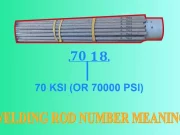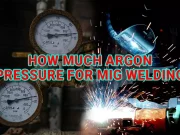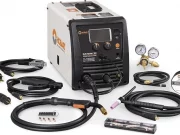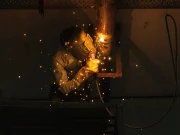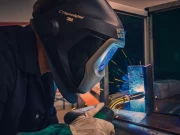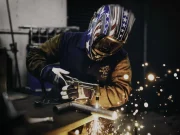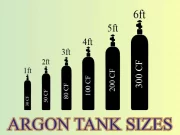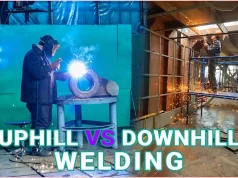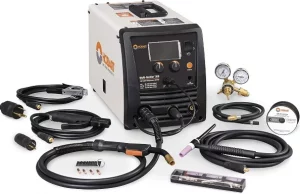
A welding arc is an electric arc used to join metals together. This arc is a product of an extended electric discharge from specific gases subjected to high voltage.
This electric discharge or current flow produces visible light, heat, and UV radiation. This light is what we see and identify as our welding arc.
This light is very bright and can be harmful if you view it with your naked eye. If you have ever seen an electric arc, you may have wondered whether it is as bright as the sun.
Now, let’s go back to the question.
How bright is an electric welding arc compared to the sun?
If you have seen an electric welding arc at night, it may appear to be as bright as the sun.
But the truth is the welding arc is nowhere near as bright as the sun. The sun is about eight times brighter than the welding arc.
We can view the sun because it is far away from the earth. However, we advise against viewing both forms of light without protective gear.
Are you interested in learning more things about this subject? Keep reading!
Things To Know About Arc Welding Radiation
The welding arc produces ultraviolet radiation, visible light, and infrared radiation. Prolonged exposure to radiation from the welding arc can be harmful to your health.
When combined with certain gases and under certain conditions, the welding arc can produce UVB and UVC radiation. The sun also emits UVA radiation in addition to UVB and UVC radiations.
Let us look at these three types of radiation.
UVC radiation:
This type of radiation is short wavelength radiation and the most deadly form of ultraviolet radiation.
Arc welding combined with an inert gas like helium produces this type of radiation.
UVC radiation from the sun does not reach the earth because of distance and the ozone layer protection.
UVB radiation:
This type of radiation is medium wavelength radiation. Both the sun and arc welding can produce this type of radiation.
UVC radiation from the sun does not reach the earth and cannot penetrate the skin.
However, UVB radiation produced by arc welding can reach and adversely impact people exposed to it. It can accelerate ageing and skin cancer.
UVA radiation:
This type of radiation is long-wavelength radiation. Again, both the sun and arc welding produce this type of radiation.
It accounts for most of the radiation that reaches the earth from the sun.
UVA radiation can penetrate the eyes and the skin. It is responsible for tanning and can accelerate ageing and cause skin cancer.
Types Of Arc Welding
We can broadly classify arc welding into consumable and non-consumable electrode methods.
A consumable arc welding method does not require filler because the welding rod melts during welding and deposits on the bead.
On the other hand, a non-consumable arc welding method requires a separate filler as the electrode remains intact during welding.
Consumable Electrode Methods
Metal Inert Gas and Metal Active Gas welding:
This type of welding protects base metals from contamination using shielding gas.
Shielded Metal Arc Welding:
This type of welding is ideal for joining both ferrous and nonferrous materials together.
The electrode used in this type of welding creates an arc between the metal rod and the surface.
The metal rod and surface both melt, creating a weld pool with slag that can protect the metal surface from oxidation from the atmosphere.
Non-consumable Electrode Metals
Tungsten inert gas welding:
In this type of welding, a tungsten electrode creates the arc and an inert gas like helium shields the weld from oxidation.
Plasma arc welding:
In this type of welding, an electric arc forms between a non-consumable electrode and an anode.
The arc then ionizes the gas to create plasma. A fine bore in the anode separates the plasma from the shielding gas.
Health Hazards Associated With Arc Welding
We have established that exposure to radiation produced by the welding arc can adversely affect human health.
Let’s look at some of the health hazards that can arise from exposure to arc welding.
Welders’ flash burn:
Welders flash burn is a painful eye condition caused by exposure to ultraviolet radiation.
Symptoms of welders’ flash burn include pain, tears, constricted pupils, eyelid twitching, and discomfort from bright light.
To treat welders’ flash burn, use cold compresses and isolate yourself in a dark room for a while. If the pain is severe, you can alleviate using pain killers.
Skin hazards:
The ultraviolet radiation from electric arc welding can harm the skin. Exposure to UVB and UVC radiation can increase the risk of skin cancer.
It does not help that most welders find clothing to be an obstruction. As a result, they sometimes ignore necessary safety protocols.
Factors like the material, shielding flux, the workshop environment and the contaminants can also increase the risk of skin cancer.
Lung cancer:
Fine particles produced in the welding process contaminate the air and can enter your nostrils. These particles can cause lung cancer.
To weld metal, you would have to heat it above its boiling point. When it cools down, some fine particles mix with the air.
Most of these particles are not visible when to the naked eye. Welders usually inhale this contaminated air in their workshop.
Welding Fumes That Can Cause Cancer
Cadmium oxides:
These alloys of stainless steel contain zinc alloy, plated materials, and cadmium. When evolved during a welding process, they can be very potent cancer-causing agents.
Beryllium:
You will find beryllium in almost every welding shop. Welders use it as a hardener in the welding process, especially for aluminum alloys.
Chromium:
Chromium is present in most high alloy materials. Welders use it frequently for plating. It is highly carcinogenic.
The Effects Of Welding Fumes
Our biological makeup as humans is different. So we react differently upon exposure to certain substances.
Some react quickly; others respond slowly. However, over time the effects begin to manifest in different forms.
Cancer:
All welding fumes are carcinogenic. Prolonged exposure to arc welding fumes increases the risk of developing cancer.
Lung and throat infection:
Welding fumes produce fine particles. When you inhale them, they can dry up your throat and cause fluids to accumulate in the lungs.This condition can lead tolung cancer.
Again, when the throat dries up, it can lead to constriction of the chest. Intense coughing can occur as a result. Some patients may need inhalers to stabilize their breathing afterwards.
Reduced lung function:
Welding fumes that accumulate in the lung increase difficulty in breathing
When combined with coughing, it can lead to asthma.
Taking a break for a while might bring some relief but doesn’t guarantee escape from lung or throat cancer in the future.
Reduced immunity:
Welding fumes can weaken the immune system, impeding the system’s ability to fight infections.
These fumes can also cause damage to the nervous system and other conditions such as kidney and ulcers problems.
Suffocation:
Exposure to carbon monoxide can cause suffocation.
Ways To Manage Exposure To Welding Fumes
Welders can take measures to mitigate possible health effects from exposure to welding fumes.
Surface preparation:
Try to remove paints or coatings on the work surface before starting the job. Do not use chlorinated solvents in the cleaning.
Consumables and welding processes:
Welders should monitor power settings to reduce the number of fumes emitted.
They also should prioritize welding processes that emit fewer fumes and UV rays. Using consumables can also be helpful as they are less harmful to the body.
Personal protective equipment:
Welders should, despite the inconvenience, put on complete protective equipment.
To avoid inhaling these harmful fumes, they should use masks that filter air. They should also use goggles or masks with ultraviolet filtered lenses to prevent eye damage.
Covering all parts of the skin with long clothing can help prevent penetration of UVB and UVC rays.
Separate space for welding:
Having a separate welding space can prevent other workers from contacting the fumes. The use of automated machines can also further reduce the risk to workers.
Rotational jobs:
Most of these adverse effects of the job result from prolonged work and contact.
Job policies that allow workers to share work can prevent them from spending prolonged time on the job.
Conclusion
A welding arc is an electronic arc used to join metals together. It emits large amounts of heat and light, so much, so that some people compare it to the sun.
However, the welding arc is nowhere near as bright as the sun. The sun is at least eight times brighter than the welding arc. This immense radiation from the welding arc possesses the full spectrum of ultraviolet radiation.
This radiation, along with the fumes from arc welding, is harmful to our health. Prolonged exposure to the radiation and fumes of arc welding can increase the possibility of cancer.
It becomes necessary for workers in a welding shop to take precautions to safeguard their health.
Surface preparation is the use of personal protective equipment is necessary preventive measures to take. We also advise welders to prioritize welding processes that emit fewer fumes and UV rays.




